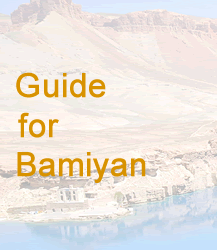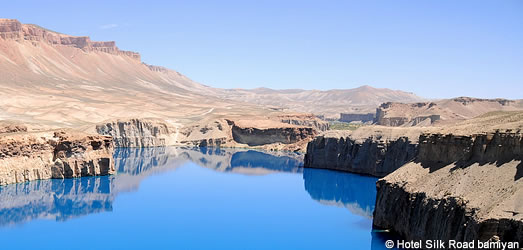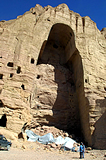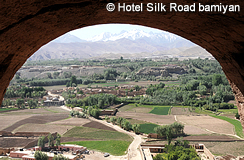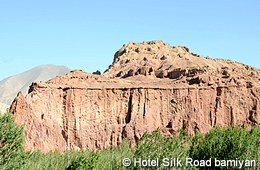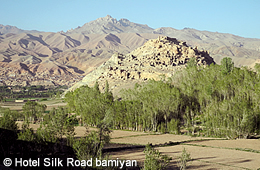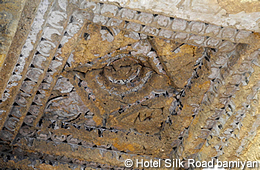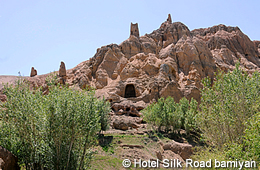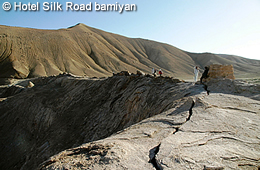Bamiyan is a basin located in a long ravine which runs East to West. In the North there are the Koh-e KhwahaGhar mountains which are an offset of the Hindukush mountain range. In the South lie the Koh-e Baba mountains. The best season to visit Bamiyan is from April to October.
Various beautiful flowers are in bloom and a variety of alpine plant can be seen in June. The row of poplars turn yellow in October and the leaves start to fall in the following month.
The beginning of Winter starts in November when the snow falls in Bamiyan.
Bamiyan was an important ancient caravan city which flourished during the days of the Silk Road. Many caravans from the East and the West passed through the city of Bamiyan during their journey on the Silk Road. The road from Bamiyan leads to Balkh in the North, Ghazni and Kandahar in the South, Kabul and Jalalabad in the East and Herat in the West. The merchants in the days of Buddhism came to Bamiyan to worship and make offerings at the temples with prayers for the safety of their journey. Although the two Giant Buddhas of Bamiyan, which were a wonderful representation of the cultural heritage of the luxury and fortune of the ancient Buddhist period, they were tragically destroyed by the Taliban, which was the previous government in Afghanistan in 2001.
Bamiyan also has many other interesting places to explore, besides the Buddhist ruins. There are remains of Islamic, medieval period, and also the beautiful nature of the valleys including Lake Pand: Band-i-Amir.
Admission tickets are necessary to get into these three places: Bamiyan caves, Shahr-i-Zohak and Shahr-i-Gholgora. Tickets are available at the office near the West Giant Buddha. US$7(300Afs) for one day ticket is valid for all three places. If you want to visit on different days you have to purchase a ticket again.
Removal of land mines was nearly finished in Bamiyan in May 2011, but it is not recommended to walk around in the old mine field.
- Shahr-i-Zohak
- Shahr-i-Gholgora
- Foladi Caves
- Kakrak Caves
- Dragon Valley
- Band-i-Amir

Bamiyan Caves
Bamiyan Caves consists of 750 caves dug into the hill 1300m in length from end to end, located on the North end of Bamiyan Valley. On the East and West end of these caves were located the two Giant Buddhas of Bamiyan which were destroyed by the Taliban in 2001. The West Buddha was 55 meters high and the East Buddha was 38m high. This place was appointed as a Cultural World Heritage Site in 2003 by UNESCO and named "The Cultural landscape and Archaeological Remains of the Bamiyan Valley". It is under restoration and preservation by UNESCO and other countries. There are still many new discoveries being unearthed everyday.
You can reach the caves from near both the Giant Buddhas. Many frescoes and murals in can be observed in the caves. You have to walk up and down at a height of 2500m. So please remember to wear comfortable shoes and use a back pack for carrying personal items.
※Admission: US$7(300Afs)for one day ticket.

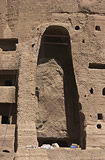
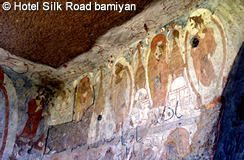
East Giant Buddha
38m high Giant Buddha was destroyed, but some of the frescoes can be seen in the caves in the West terrace.On the ceiling can be observed some decorations : Laternendecke, Vault and Squinch arch.
You can walk from the East entrance towards the West through a narrow passage above the head section of the East Buddha
West Giant Buddha
Though there are no frescoes or murals to be seen, but you can go to the head section of the West Giant Buddha by climbing the side slope.Shahr-i-Zohak
This fortress, the Shahr-i-Zohak is located at the entrance to Bamiyan Valley, and it is the first glorious sight you will see when you approach from Kabul through the Shiber Pass. It is a beautiful commemoration to the past and shines beautifully at sunset, hence it is called the "Red City". You can see the beautiful panoramic view of the Bamiyan Valley and the Kalu river from the peak above the fortress.
※Admission: US$7(300Afs) for one day ticket.
Shahr-i-Gholghola
This is the ruin of a fort called "The City of Screaming Ghosts". Those fort was a flourishing city in Bamiyan of the 12th century during the period of the Shansabani dynasty, a descendant of the Ghor Dynasty. In 1221 Genghis Khan and his troops attacked the city and slaughtered all the residents there. The screaming of the men, women and children who were mercilessly killed in this mass genocide echoed from corner to corner of the fort and gave it the name of "The City of Screaming Ghosts". Despite this history of blood, the view from the top of the parapets is a sight to behold. The panoramic view of Bamiyan valley will take your breath away .※Admission: US$7 for one day ticket.
Foladi Caves
These caves were constructed along the Foladi river which runs along the west side of the Bamiyan valley. There are 50 caves in all which were partially destroyed in the recent wars. However, you can still see the beautiful ceiling drawings such as the "Laternendecke", even today.Kakrak Caves
The Kakrak Caves are located along the Kakrak river which runs on the 6km Southeast of the city. Here were painted the famous murals, which are now in safe custody in the Gumet Museum(France) and the Kabul Museum. These murals show you how the Mandalas were formed. They are a marvellous piece of work based in the color red. There used to be a 6.4m high standing statue of the Buddha, which was destroyed by the Taliban (the previuos government of Afghanistan) in 2001, along with the two Giant Buddhas. You will also come across the ruins of an Islamic watch tower, which has also been razed to the ground. Unfortunately, nothing is left today.Dragon Valley
This valley is located 9km Southwest of Bamiyan. According to a legend, when a village maiden was about to be offered as a sacrifice to the dragon, a hero named "Hazrat Ali" fought against the dragon and cut it into half from head to tail. The dragon shed tears of repentance. The split back of the dragon fell apart and created the Bamiyan valley and the "the tears" originating from a natural spring, are still flowing down the valley. Now at the mouth of a valley a new colony has been built by the returning refugees from Iran.Band-i-Amir
Band-i-Amir consists of a group of beautiful lakes and marshes located 75km west of Bamiyan. These blue colored lakes will suddenly appear before you as you drive up, located at a height of about 3,000m above sea level. After you cross over the beautiful Shahidan pass at about 3,300m above sea level, a gentle upward slope up the hill will lead you there. You will have a grand view of the grassy pastures and the rare alpine plants which thrive there.The Band-i-Amir is also called the "Pearl of the Desert" because of its fantastically beautiful colored waters, which changes in color with the reflection of the moving sun across the sky. There are a total of 5 lakes. The largest lake is Band-i-Zulufikul. Band-i-Haibat is in the center. The other lakes are Band-i-Pdina, Band-i-Panir, Band-i-Graman. (Band-i-Kanbul is nearly dried up now.) There is a sacred place by Band-i-Haibat where prophet Hazrat Ali once spent a night. This hole ground is visited by many pilgrims even today.
※Admission: 100Afs per car.
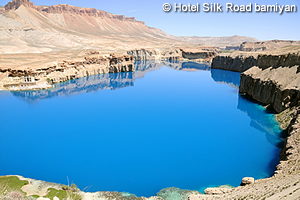
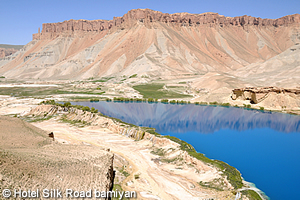
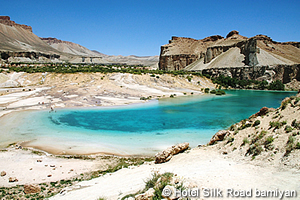
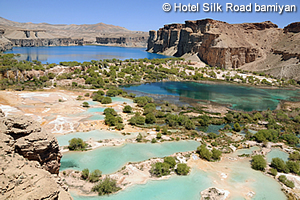
The beauty of Band-i-Amir is indeed like the blue colored jewel Lapizlazuli and should be appreciated with your own eyes. Under the exotic sun of Afghanistan the panoramic view of the blue lakes will dazzle your eyes and your heart. Hotel Silk Road can arrange cars and also prepare your picnic lunch should you decide to go there.

